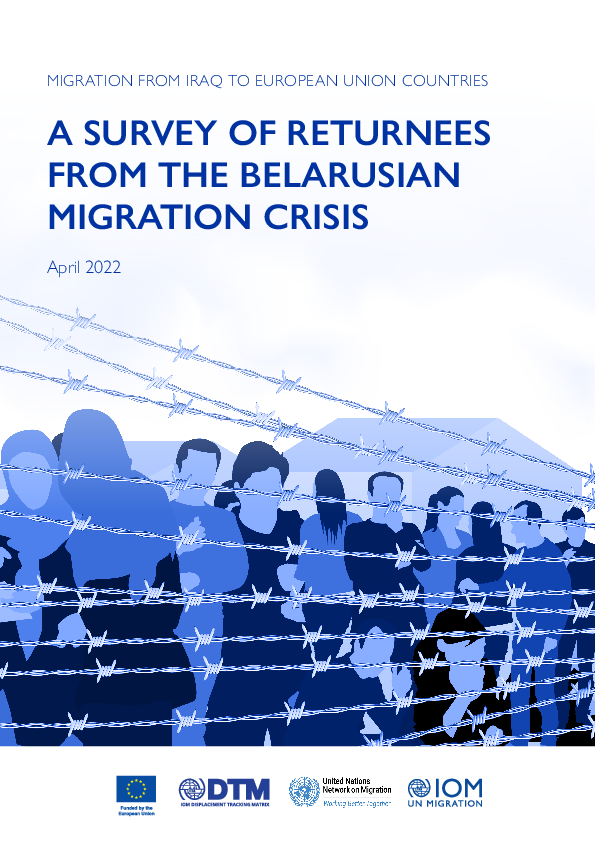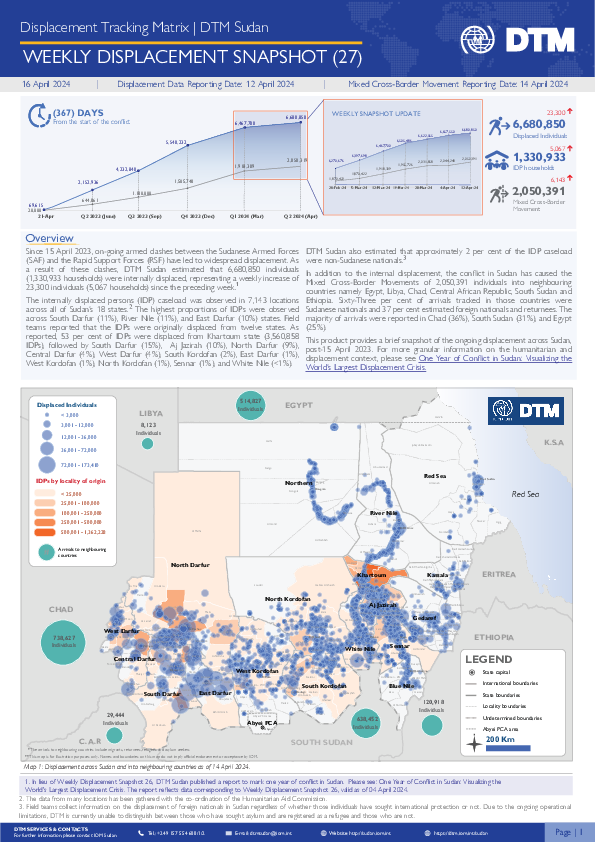-
Countries
-
Data and Analysis
-
Special Focus
-
Crisis Responses

Contact
IraqDTM@iom.int
Language
English
Location
Iraq
Period Covered
Sep 01 2020
Sep 30 2021
Activity
- Survey
- Flow Monitoring
DTM Iraq collects data at border crossing points with neighbouring countries – the Islamic Republic of Iran (Iran), the Syrian Arab Republic (Syria) and Turkey – to better understand migration movements in the Middle East. Cross-border monitoring is designed to capture and describe migration flows, and is part of IOM DTM’s Regional Evidence for Migration Analysis and Policy (REMAP) project, funded by the European Union. The project aims to capture and describe migration flows in Afghanistan, Bangladesh, Iran, Iraq and Pakistan. The United Nations Development Assistance Framework (UNDAF) funded this piece of research.
This report seeks to identify migrants in vulnerable situations entering and departing Iraq who may be susceptible to trafficking in persons and/or other forms of abuse, violence and exploitation along their migratory journey. The aim is to gain a better understanding of the profile of the vulnerable groups, the means of organizing travel, push-factors in the decision-making process, level of risk-awareness and problems encountered during the journey.
Data displayed in this report were collected using two approaches: a headcount of all travellers entering or departing Iraq though the specified border points where DTM have data collection teams stationed and a survey of randomly selected travellers. Data collection took place between 1 September 2020 and 30 September 2021 at five border crossing points: Ibrahim Al-Khalil, bordering Turkey, Fishkhabour, bordering Syria, and Bashmagh, Zurbatiyah (Wassit Terminal) and Al-Shalamcha, bordering Iran. During this period, a total of 14,598 interviews were conducted with randomly selected travellers entering and departing Iraq.

Contact
IraqDTM@iom.int
Language
English
Location
Iraq
Period Covered
Feb 01 2022
Feb 28 2022
Activity
- Survey
- Flow Monitoring
During the recent migration crisis in Belarus, thousands of Iraqis experienced harassment, exposure and violence. Many returned, via IOM
facilitated movements through the Assisted Voluntary Return and Reintegration (AVRR) programme and via movements organised and supported by the Government of Iraq from Belarus and neighbouring countries of the European Union (EU). Potential emigrants from Iraq began to travel to Belarus, Lithuania, Latvia and Poland in large numbers in the second half of 2021. In the context of negotiations between the Government of Belarus and the EU, the Government of Belarus’ relaxation of visa policies and a travel information campaign in Iraq, there was a significant increase in the number of potential emigrants from Iraq travelling to Belarus. Many of those potential emigrants travelled with the intention of onward travel to enter the European Union or the United Kingdom.
With the suspension of flights from Baghdad to Belarus in August 2021, potential emigrants from Iraq began to use alternative routes to reach
Belarus and neighbouring EU countries, including from airports in Erbil and Sulaymaniyah. The increase of Iraqi emigrants entering Belarus resulted in a crisis when Belarusian security forces began to move migrants to the country’s borders with Poland, Lithuania and Latvia. This was accompanied by reports of violence and abuse against Iraqi migrants at the border, many of whom were reportedly unable to move into Europe or back into Belarus. As a result, the Government of Iraq (GoI), facilitated the return of approximately 3,800 Iraqi migrants. The International Organisation for Migration (IOM), with the support of the European Union, have continued to facilitate the voluntary return of Iraqi migrants from Belarus and EU countries.

Contact
DTM Pakistan, iomisbdtmremapteam@iom.int
Language
English
Location
Pakistan
Period Covered
Apr 01 2024
Apr 15 2024
Activity
- Flow Monitoring
The International Organization for Migration (IOM) in Pakistan collects data on the outflows of Afghans at the Torkham (Khyber Pakhtunkhwa), Badini, Bahramcha, and Chaman (Balochistan) border crossing points (BCPs) to better understand the movements of Afghans returning to Afghanistan. The data is harmonized with those from the United Nations High Commissioner for Refugees (UNHCR), who also cover the Ghulam Khan (Khyber Pakhtunkhwa) BCP.
On 26 September 2023, the Ministry of Interior in Pakistan announced its decision to enact its “Illegal Foreigners’ Repatriation Plan (IFRP)”. Between 1 and 15 April 2024, a total of 8,261 Afghan nationals returned to Afghanistan, including 6,770 through the Torkham BCP, 877 through the Chaman BCP, and 614 through the Ghulam Khan BCP, while no Afghan nationals returned through the Badini and Bahramcha BCPs. In addition, border authorities deported 71 individuals due to a lack of valid documentation. Since 1 January 2024, IOM identified 62,559 returns at the four BCPs.

Contact
DTMUkraine@iom.int
Language
English
Location
Ukraine
Period Covered
Mar 01 2024
Mar 31 2024
Activity
- Baseline Assessment
Базова територіальна оцінка зареєстрованих ВПО надає деталізовані дані щодо чисельності та географічного розподілу офіційно зареєстрованих внутрішньо переміщених осіб (ВПО). У звіті оцінено присутність зареєстрованих ВПО на рівні громад із відображенням на мапі зафіксованих змін порівняно з попереднім раундом.
Дані, зібрані для раунду 34 Базової територіальної оцінки, відображають актуальну статистику з місцевого адміністративного реєстру ВПО станом на 31 березня 2024 року, згідно з якою в Україні налічується 3 387 291 зареєстрована ВПО. Дані щодо кількості зареєстрованих ВПО було зібрано для 1 098 громад (83% усіх оцінених громад на підконтрольних українському уряду територіях) у 108 районах 23 областей. Дані з розподілом за віком, статтю та статусом інвалідності було надано для приблизно 83% оцінених адміністративно- територіальних одиниць.

Contact
dtmmozambique@iom.int
Language
English
Location
Mozambique
Period Covered
Apr 11 2024
Apr 16 2024
Activity
- Survey
- Return Intention
IOM’s Displacement Tracking Matrix in collaboration with SDPI conducted a Movement Intention Survey to 783 households hosting 3,136 individuals displaced from Chiure and Macomia districts in Cabo Delgado. Conflict and/or “fear of attacks” due to Non-State Armed Groups (NSAGs) in Cabo Delgado was the main trigger of displacement. At least 70% were displaced from Chiure Velho. 26% from Mazeze and 2% were from Ocua posto. Other postos of origin includes Chiure sede, Katapula, Quiterajo and Mucojo.
The objective of the assessment was to better understand the conditions of the IDP households in the current place of displacement and their short-term intentions. An on-going household verification exercise confirmed the presence of 1,965 households hosting 8,600 individuals in Chiure Posto. Females constitutes 55% of the IDPs whilst 45% are males. Children make up 58% of those remaining displaced within the district.

Contact
DTM Burundi, DTMBurundi@iom.int
Language
English
Location
Burundi
Period Covered
Apr 08 2024
Apr 15 2024
Activity
- Mobility Tracking
- Event Tracking
Le rapport DTM indique qu'entre le 8 et le 14 avril 2024, au Burundi, 13 674 personnes ont été affectées et 3 715 déplacées suite à des pluies torrentielles, des glissements de terrain, des inondations et des vents violents nécessitant une réponse immédiate de la communauté humanitaire. Parmi les affectés, 7 546 sont des femmes et 6 128 sont des hommes. La répartition par type d'urgence montre que les pluies torrentielles ont affecté 6 983 personnes et en ont déplacé 2 507, les glissements de terrain ont affecté 6 046 personnes et en ont déplacé 793, les inondations ont affecté 359 personnes et en ont déplacé 256, et les vents violents ont affecté 286 personnes et en ont déplacé 159. Les groupes vulnérables comprennent 122 femmes enceintes ou allaitantes, 3 hommes seuls chefs de ménage, 7 personnes avec une maladie chronique, 15 personnes handicapées et 10 personnes âgées vivant seules. Les dommages incluent de nombreuses habitations ainsi que des infrastructures telles que des écoles, des églises et des bâtiments administratifs. Cette situation met en lumière la nécessité d'une aide humanitaire continue et ciblée dans la région.

Contact
DTMUkraine@iom.int
Language
English
Location
Ukraine
Period Covered
Nov 27 2023
Dec 27 2023
Activity
- Survey
Профілі областей ґрунтуються на даних раунду 15 Опитування загального населення МОМ, з акцентом на демографічних показниках і переміщенні населення, довгострокових рішеннях, достатності житла, базових потребах, зайнятості та доходах, а також соціальній згуртованості. Ці дані, згруповані за групами населення на обласному рівні, покликані сприяти прийняттю обґрунтованих рішень щодо стратегічних, технічних і програмних аспектів гуманітарного реагування та відновлення в Україні на основі фактичних даних.

Contact
iomguatemala@iom.int
Language
English
Location
Guatemala
Period Covered
Feb 01 2024
Feb 29 2024
Activity
- Flow Monitoring
In Februrary 2024, 22,402 movements were observed in Guatemala (18% children) and 400 individuals were surveyed.1 The number of observed movements decreased by 6 per cent from January 2024 (23,690) due to operational constraints in data collection. More than half of surveyed individuals originated from the Bolivarian Republic of Venezuela (63%). The main intended destination was the United States of America (90%).
Since 2022, migratory flows through the Latin America and Caribbean region have increased significantly, with record levels of persons crossing the perilous jungle of the Darién National Park from Colombia into Panama. The in-transit flows tracked in Guatemala have mirrored these regional migration trends.

Contact
iomguatemala@iom.int
Language
English
Location
Guatemala
Period Covered
Feb 01 2024
Feb 29 2024
Activity
- Flow Monitoring
En febrero de 2024 se observaron 22,402 movimientos en Guatemala (18% niños, niñas y adolescentes) y 400 personas fueron encuestadas.1 El número de movimientos observados disminuyó un 6 por ciento desde enero de 2024 (23,690) debido a limitaciones operativas en la recolección de datos. Más de la mitad de las personas encuestadas procedía de la República Bolivariana de Venezuela (63%). El principal destino previsto fue los Estados Unidos de América (90%).
Desde 2022, los flujos de migrantes en tránsito se incrementaron significativamente en la región de América Latina y el Caribe, observando cantidades nunca antes registradas de personas que cruzan la peligrosa selva del Parque Nacional del Darién desde Colombia hacia Panamá. Los flujos en tránsito observados en Guatemala han reflejado dichas tendencias migratorias regionales

Contact
DTM Sudan; dtmsudan@iom.int
Language
English
Location
Sudan
Period Covered
Apr 05 2024
Apr 12 2024
Activity
- Mobility Tracking
- Baseline Assessment
This report reflects data corresponding to Weekly Displacement Snapshot 27 dataset, valid as of 12 April 2024. The dataset is available here.
Overview
On 15 April 2023, armed clashes erupted between the Sudanese Armed Forces (SAF) and the Rapid Support Forces (RSF) in multiple cities across Sudan. Clashes initially took place in cities across Northern and Khartoum states, later spreading across the Darfur and Kordofan regions.
Highlights
- DTM Sudan estimates that 6,680,850 individuals (1,330,933 households) were recently internally displaced.
- The IDP caseload was observed in 7,143 locations across all of Sudan’s 18 states.
- The highest proportions of IDPs were observed across South Darfur (11%), River Nile (11%), and East Darfur (10%).
- Field teams reported that the IDPs observed were originally displaced from twelve states. The majority (3,560,858 IDPs, 54%) were reportedly displaced from Khartoum state; followed by South Darfur (15%), Aj Jazirah (10%), North Darfur (9%), Central Darfur (4%), West Darfur (4%), South Kordofan (2%), East Darfur (1%), West Kordofan (1%), North Kordofan (1%), Sennar (1%) and White Nile (<1%).
- IOM-DTM also reported that an estimated 2,050,391 mixed cross-border movements were made into neighbouring countries.
- This product provides brief insights into those displaced in Sudan post-15 April 2023. For more granular information on the IDP caseload and the displacement context, please see IOM-DTM's One Year of Conflict in Sudan: Visualizing the World's Largest Displacement Crisis.
Note: In lieu of Weekly Displacement Snapshot 26, DTM Sudan published a report to to mark one year of conflict in Sudan. Please see: One Year of Conflict in Sudan: Visualizing the World's Largest Displacement Crisis. The report reflects data corresponding to Weekly Displacement Snapshot 26 dataset, valid as of 04 April 2024.
